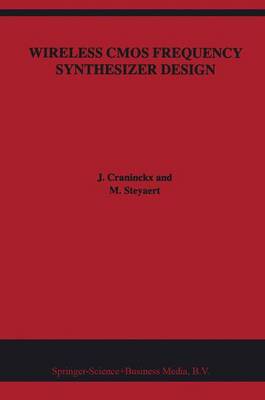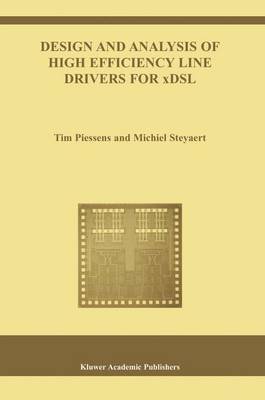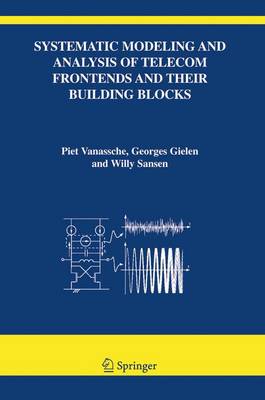The Springer International Series in Engineering and Computer Science
6 primary works
Book 439
Wireless CMOS Frequency Synthesizer Design
by J Craninckx and Michiel Steyaert
Book 686
Design of Multi-Bit Delta-Sigma A/D Converters
by Yves Geerts, Michiel Steyaert, and Willy M Sansen
This book discusses both architecture and circuit design aspects of Delta-Sigma A/D converters, with a special focus on multi-bit implementations. The emphasis is on high-speed high-resolution converters in CMOS for ADSL applications, although the material can also be applied for other specification goals and technologies.
Book 759
Design and Analysis of High Efficiency Line Drivers for Xdsl
by Tim Piessens and Michiel Steyaert
Design and Analysis of High Efficiency Line Drivers for xDSL covers the most important building block of an xDSL (ADSL, VDSL, ...) system: the line driver. Traditional Class AB line drivers consume more than 70% of the total power budget of state-of-the-art ADSL modems. This book describes the main difficulties in designing line drivers for xDSL. The most important specifications are elaborated staring from the main properties of the channel and the signal properties. The traditional (class AB), state-of-the-art (class G) and future technologies (class K) are discussed.
The main part of Design and Analysis of High Efficiency Line Drivers for xDSL describes the design of a novel architecture: the Self-Oscillating Power Amplifier or SOPA.
Book 842
Systematic Modeling and Analysis of Telecom Frontends and Their Building Blocks
by Piet Vanassche, Georges Gielen, and Willy M Sansen
However, the growing complexity of the integrated systems being designed today together with the increasing fragility of analog components brought about by shrinking geometries and reducedpowerconsumptionisposingseverechallengestotraditionalanalogdesigners to produce satisfactory results in a short time. At the same time, the need for expe- enced analog designers has increased constantly since almost all designs, because of integration,docontainanalogcomponents. Thissituationhascreatedastronginterest in developing design methodologies and supporting tools that are based on rigorous, mathematically literate, approaches. Doing so will make it possible to leverage the expertiseofseasonedanalogdesignersandtotrainnewgenerationsfasterandbetter. Inthepast, severalattemptshavebeenmadeinacademia andindustrytocreatethese methodologies and to extend the set of tools available. They have had questionable acceptance in the analog design community. However, recently, a ?urry of start-ups andincreasedinvestmentbyEDAcompaniesinnoveltoolssignalasigni?cantchange inmarketattentiontotheanalogdomain. Ipersonallybelievethattosubstantially- prove quality and design time, tools are simply insuf?cient.
A design methodology based on a hierarchy of abstraction layers, successive re?nement between two ad- cent layers, and extensive veri?cation at every layer is necessary. To do so, we need to build theories and models that have strong mathematical foundations. The analog design technology community is as strong as it has ever been.
Book 843
Lna-Esd Co-Design for Fully Integrated CMOS Wireless Receivers
by Paul Leroux, Michiel Steyaert, and LeRoux Paul
LNA-ESD Co-Design for Fully Integrated CMOS Wireless Receivers fits in the quest for complete CMOS integration of wireless receiver front-ends. With a combined discussion of both RF and ESD performance, it tackles one of the final obstacles on the road to CMOS integration. The book is conceived as a design guide for those actively involved in the design of CMOS wireless receivers.
The book starts with a comprehensive introduction to the performance requirements of low-noise amplifiers in wireless receivers. Several popular topologies are explained and compared with respect to future technology and frequency scaling. The ESD requirements are introduced and related to the state-of-the-art protection devices and circuits.
LNA-ESD Co-Design for Fully Integrated CMOS Wireless Receivers provides an extensive theoretical treatment of the performance of CMOS low-noise amplifiers in the presence of ESD-protection circuitry. The influence of the ESD-protection parasitics on noise figure, gain, linearity, and matching are investigated. Several RF-ESD co-design solutions are discussed allowing both high RF-performance and good ESD-immunity for frequencies up to and beyond 5 GHz. Special attention is also paid to the layout of both active and passive components.
LNA-ESD Co-Design for Fully Integrated CMOS Wireless Receivers offers the reader intuitive insight in the LNA's behavior, as well as the necessary mathematical background to optimize its performance. All material is experimentally verified with several CMOS implementations, among which a fully integrated GPS receiver front-end. The book is essential reading for RF design engineers and researchers in the field and is also suitable as a text book for an advanced course on the subject.Book 859
This unique book contains all topics of importance to the analog designer which are essential to obtain sufficient insights to do a thorough job. The book starts with elementary stages in building up operational amplifiers. The synthesis of opamps is covered in great detail. Many examples are included, operating at low supply voltages. Chapters on noise, distortion, filters, ADC/DACs and oscillators follow. These are all based on the extensive amount of teaching that the author has carried out world-wide.





